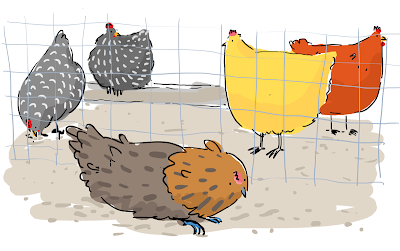Smile because it happened."
-- Dr. Seuss
I buried Fern yesterday.
She died on Christmas.
Probably not a significant day, to a chicken.
It just happened to be the right day for Fern to let go.
Fern had courageously and hysterically battled illness since June.
I helped her, perhaps more than I should have.
But she just kept singing and being silly and, well, being Fern.
She wasn't ready to give up, so I didn't give up either.
I kept her going, hoping she would acquire more strength to fight.
After all, Lucy recovered.
And she thrived.
Fern helped me to understand that sometimes valiant efforts should not be taken to keep a beloved pet alive.
For the past month, I have watched her condition deteriorate, ever so slowly.
I knew she wouldn't make it through the winter.
On Christmas morning Fern was sleepy, and she didn't sing to me when I lifted her from the nest box. When I offered her food and drink, she showed no interest.
That afternoon when I visited the ladies,they were all hanging out with Fern.
It felt to me like a vigil.
It was not a sad moment.
Just a quiet flock-moment.
Fern died a few hours later.
. . . . . . . . . . .
She was a gorgeous bird.She spent nearly three years as a chicken,
but she never did grow up.
Fern was a chickadee-chaser.

She challenged authority.
and she was number one on Lil'White's hit list.
Memories of Fern will always bring a chuckle, and I will smile because she "happened."
. . . . . . . . . . . . . .
Now I look toward Spring.
Normally, I lustily peruse my flower and seed catalogs all through the winter.
But this winter I'll be thumbing through chicken catalogs.
I'd like to increase my flock to seven or eight.
Maybe I'll get a Spitzhauben, a Wyandotte .... Definitely another Barred Rock....
Isn't it wonderful how life just keeps rolling along?
I can't wait to meet my new characters!





































































